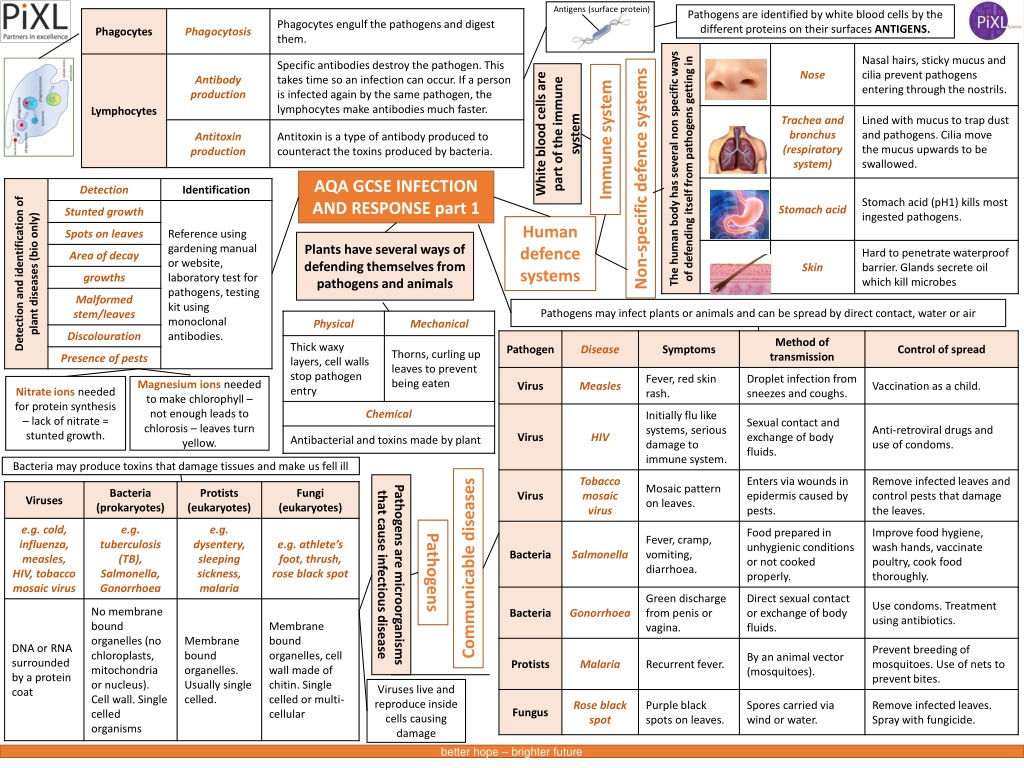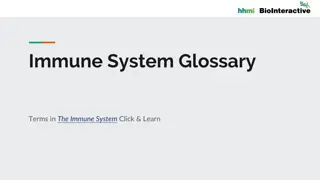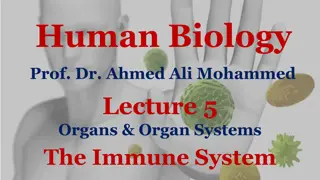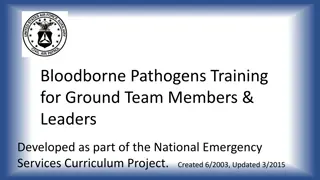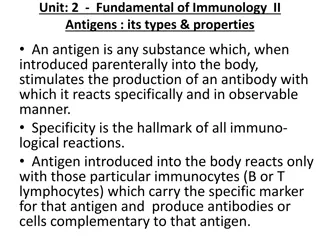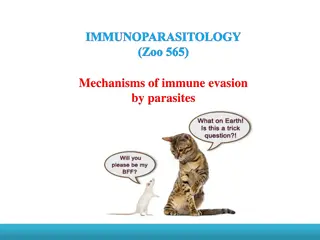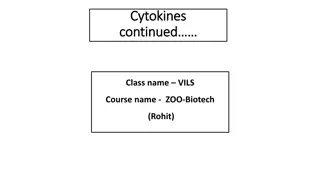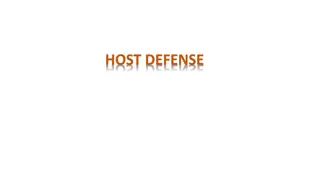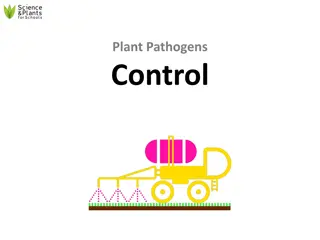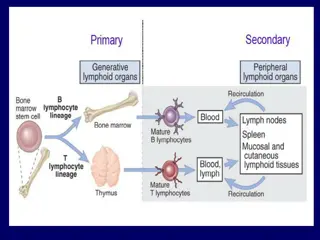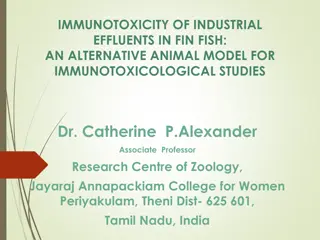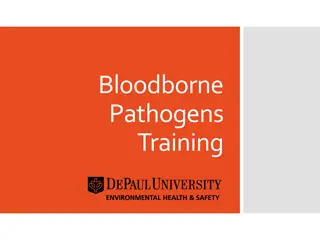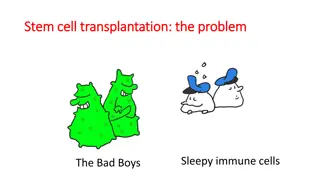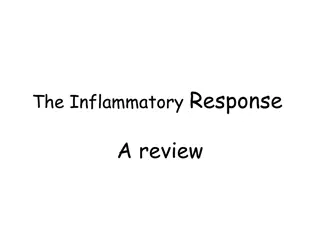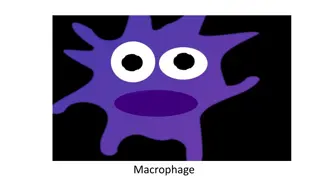Understanding Pathogens and Immune Response Mechanisms
Pathogens, such as bacteria, viruses, and fungi, can cause infectious diseases in humans, animals, and plants. The immune system defends against these pathogens through various mechanisms, including the production of antibodies, phagocytosis, and the activation of specific defense cells like white blood cells. Different strategies are used by organisms to prevent pathogen entry and spread. Understanding these interactions is crucial in managing and controlling infectious diseases.
Download Presentation

Please find below an Image/Link to download the presentation.
The content on the website is provided AS IS for your information and personal use only. It may not be sold, licensed, or shared on other websites without obtaining consent from the author. Download presentation by click this link. If you encounter any issues during the download, it is possible that the publisher has removed the file from their server.
E N D
Presentation Transcript
Antigens (surface protein) Pathogens are identified by white blood cells by the different proteins on their surfaces ANTIGENS. Phagocytes engulf the pathogens and digest them. Phagocytes Phagocytosis The human body has several non specific ways Nasal hairs, sticky mucus and cilia prevent pathogens entering through the nostrils. of defending itself from pathogens getting in Specific antibodies destroy the pathogen. This takes time so an infection can occur. If a person is infected again by the same pathogen, the lymphocytes make antibodies much faster. Non-specific defence systems White blood cells are Nose part of the immune Antibody production Immune system Lymphocytes system Trachea and bronchus (respiratory system) Lined with mucus to trap dust and pathogens. Cilia move the mucus upwards to be swallowed. Antitoxin production Antitoxin is a type of antibody produced to counteract the toxins produced by bacteria. AQA GCSE INFECTION AND RESPONSE part 1 Detection Identification Detection and identification of Stomach acid (pH1) kills most ingested pathogens. Stomach acid Stunted growth plant diseases (bio only) Spots on leaves Reference using gardening manual or website, laboratory test for pathogens, testing kit using monoclonal antibodies. Plants have several ways of defending themselves from pathogens and animals Hard to penetrate waterproof barrier. Glands secrete oil which kill microbes Area of decay Skin growths Malformed stem/leaves Pathogens may infect plants or animals and can be spread by direct contact, water or air Physical Mechanical Discolouration Method of transmission Thick waxy layers, cell walls stop pathogen entry Pathogen Disease Symptoms Control of spread Thorns, curling up leaves to prevent being eaten Presence of pests Fever, red skin rash. Droplet infection from sneezes and coughs. Magnesium ions needed to make chlorophyll not enough leads to chlorosis leaves turn yellow. Virus Measles Vaccination as a child. Nitrate ions needed for protein synthesis lack of nitrate = stunted growth. Chemical Initially flu like systems, serious damage to immune system. Sexual contact and exchange of body fluids. Anti-retroviral drugs and use of condoms. Virus HIV Antibacterial and toxins made by plant Bacteria may produce toxins that damage tissues and make us fell ill Tobacco mosaic virus Enters via wounds in epidermis caused by pests. Remove infected leaves and control pests that damage the leaves. Communicable diseases Mosaic pattern on leaves. Pathogens are microorganisms Bacteria (prokaryotes) Protists (eukaryotes) Fungi that cause infectious disease Virus Viruses (eukaryotes) e.g. cold, influenza, measles, HIV, tobacco mosaic virus e.g. e.g. Food prepared in unhygienic conditions or not cooked properly. Improve food hygiene, wash hands, vaccinate poultry, cook food thoroughly. Pathogens Fever, cramp, vomiting, diarrhoea. tuberculosis (TB), Salmonella, Gonorrhoea dysentery, sleeping sickness, malaria e.g. athlete s foot, thrush, rose black spot Bacteria Salmonella Green discharge from penis or vagina. Direct sexual contact or exchange of body fluids. Use condoms. Treatment using antibiotics. No membrane bound organelles (no chloroplasts, mitochondria or nucleus). Cell wall. Single celled organisms Bacteria Gonorrhoea Membrane bound organelles, cell wall made of chitin. Single celled or multi- cellular Membrane bound organelles. Usually single celled. DNA or RNA surrounded by a protein coat Prevent breeding of mosquitoes. Use of nets to prevent bites. By an animal vector (mosquitoes). Protists Malaria Recurrent fever. Viruses live and reproduce inside cells causing damage Rose black spot Purple black spots on leaves. Spores carried via wind or water. Remove infected leaves. Spray with fungicide. Fungus better hope brighter future
Antigens (surface protein) Pathogens are identified by white blood cells by the different proteins on their surfaces ANTIGENS. Phagocytes engulf the pathogens and digest them. Phagocytosis Nasal hairs, sticky mucus and cilia prevent pathogens entering through the nostrils. Specific antibodies destroy the pathogen. This takes time so an infection can occur. If a person is infected again by the same pathogen, the lymphocytes make antibodies much faster. Non-specific defence systems White blood cells are Nose part of the immune Antibody production Immune system system Trachea and bronchus (respiratory system) Lined with mucus to trap dust and pathogens. Cilia move the mucus upwards to be swallowed. Antitoxin production Antitoxin is a type of antibody produced to counteract the toxins produced by bacteria. AQA GCSE INFECTION AND RESPONSE part 1 Detection Identification Stomach acid (pH1) kills most ingested pathogens. Stomach acid Stunted growth Spots on leaves Reference using gardening manual or website, laboratory test for pathogens, testing kit using monoclonal antibodies. Plants have several ways of defending themselves from pathogens and animals Hard to penetrate waterproof barrier. Glands secrete oil which kill microbes Area of decay Skin growths Malformed stem/leaves Pathogens may infect plants or animals and can be spread by direct contact, water or air Physical Mechanical Discolouration Method of transmission Thick waxy layers, cell walls stop pathogen entry Pathogen Disease Symptoms Control of spread Thorns, curling up leaves to prevent being eaten Presence of pests Fever, red skin rash. Droplet infection from sneezes and coughs. Magnesium ions needed to make chlorophyll not enough leads to chlorosis leaves turn yellow. Measles Vaccination as a child. Nitrate ions needed for protein synthesis lack of nitrate = stunted growth. Chemical Initially flu like systems, serious damage to immune system. Sexual contact and exchange of body fluids. Anti-retroviral drugs and use of condoms. HIV Antibacterial and toxins made by plant Bacteria may produce toxins that damage tissues and make us fell ill Tobacco mosaic virus Enters via wounds in epidermis caused by pests. Remove infected leaves and control pests that damage the leaves. Communicable diseases Mosaic pattern on leaves. Pathogens are microorganisms that cause infectious disease e.g. cold, influenza, measles, HIV, tobacco mosaic virus e.g. e.g. Food prepared in unhygienic conditions or not cooked properly. Improve food hygiene, wash hands, vaccinate poultry, cook food thoroughly. Pathogens Fever, cramp, vomiting, diarrhoea. tuberculosis (TB), Salmonella, Gonorrhoea dysentery, sleeping sickness, malaria e.g. athlete s foot, thrush, rose black spot Salmonella Green discharge from penis or vagina. Direct sexual contact or exchange of body fluids. Use condoms. Treatment using antibiotics. No membrane bound organelles (no chloroplasts, mitochondria or nucleus). Cell wall. Single celled organisms Gonorrhoea Membrane bound organelles, cell wall made of chitin. Single celled or multi- cellular Membrane bound organelles. Usually single celled. DNA or RNA surrounded by a protein coat Prevent breeding of mosquitoes. Use of nets to prevent bites. By an animal vector (mosquitoes). Malaria Recurrent fever. Viruses live and reproduce inside cells causing damage Rose black spot Purple black spots on leaves. Spores carried via wind or water. Remove infected leaves. Spray with fungicide. better hope brighter future
Antigens (surface protein) Pathogens are identified by white blood cells by the different proteins on their surfaces ANTIGENS. Phagocytes engulf the pathogens and digest them. Nasal hairs, sticky mucus and cilia prevent pathogens entering through the nostrils. Specific antibodies destroy the pathogen. This takes time so an infection can occur. If a person is infected again by the same pathogen, the lymphocytes make antibodies much faster. Non-specific defence systems White blood cells are part of the immune Immune system system Lined with mucus to trap dust and pathogens. Cilia move the mucus upwards to be swallowed. Antitoxin is a type of antibody produced to counteract the toxins produced by bacteria. AQA GCSE INFECTION AND RESPONSE part 1 Detection Identification Stomach acid (pH1) kills most ingested pathogens. Reference using gardening manual or website, laboratory test for pathogens, testing kit using monoclonal antibodies. Plants have several ways of defending themselves from pathogens and animals Hard to penetrate waterproof barrier. Glands secrete oil which kill microbes Pathogens may infect plants or animals and can be spread by direct contact, water or air Method of transmission Thick waxy layers, cell walls stop pathogen entry Pathogen Disease Symptoms Control of spread Thorns, curling up leaves to prevent being eaten Fever, red skin rash. Droplet infection from sneezes and coughs. Magnesium ions needed to make chlorophyll not enough leads to chlorosis leaves turn yellow. Vaccination as a child. Nitrate ions needed for protein synthesis lack of nitrate = stunted growth. Initially flu like systems, serious damage to immune system. Sexual contact and exchange of body fluids. Anti-retroviral drugs and use of condoms. Antibacterial and toxins made by plant Bacteria may produce toxins that damage tissues and make us fell ill Enters via wounds in epidermis caused by pests. Remove infected leaves and control pests that damage the leaves. Communicable diseases Mosaic pattern on leaves. Pathogens are microorganisms that cause infectious disease Food prepared in unhygienic conditions or not cooked properly. Improve food hygiene, wash hands, vaccinate poultry, cook food thoroughly. Pathogens Fever, cramp, vomiting, diarrhoea. Green discharge from penis or vagina. Direct sexual contact or exchange of body fluids. Use condoms. Treatment using antibiotics. No membrane bound organelles (no chloroplasts, mitochondria or nucleus). Cell wall. Single celled organisms Membrane bound organelles, cell wall made of chitin. Single celled or multi- cellular Membrane bound organelles. Usually single celled. DNA or RNA surrounded by a protein coat Prevent breeding of mosquitoes. Use of nets to prevent bites. By an animal vector (mosquitoes). Recurrent fever. Viruses live and reproduce inside cells causing damage Purple black spots on leaves. Spores carried via wind or water. Remove infected leaves. Spray with fungicide. better hope brighter future
Antigens (surface protein) Pathogens are identified by white blood cells by the different proteins on their surfaces ANTIGENS. Non-specific defence systems White blood cells are part of the immune Immune system system AQA GCSE INFECTION AND RESPONSE part 1 Detection Identification Plants have several ways of defending themselves from pathogens and animals Pathogens may infect plants or animals and can be spread by direct contact, water or air Method of transmission Pathogen Disease Symptoms Control of spread Magnesium ions needed to make chlorophyll not enough leads to chlorosis leaves turn yellow. Nitrate ions needed for protein synthesis lack of nitrate = stunted growth. Bacteria may produce toxins that damage tissues and make us fell ill Communicable diseases Pathogens are microorganisms that cause infectious disease Pathogens Viruses live and reproduce inside cells causing damage better hope brighter future
